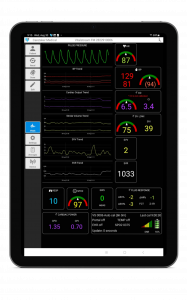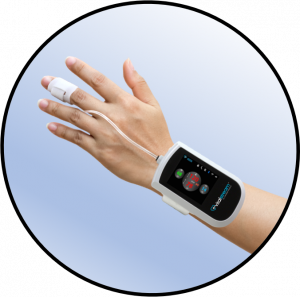VitalStream offers veterans uninterrupted hemodynamic and vital signs monitoring to aid in the early detection of decline and precise treatment.
Caretaker’s VitalStream® will offer VA medical centers the ability to continuously and non-invasively monitor blood pressure, cardiac output, stroke volume, fluid responsiveness and other advanced hemodynamic parameters throughout all hospital departments.
This level of monitoring has been previously unavailable outside of the operating room and intensive care unit, and is usually reserved for higher-risk patients and procedures since it involves invasive lines or uncomfortable and restrictive devices. VitalStream can expand advanced monitoring capabilities to more patients and can lead to earlier detection of clinical decompensation, promote root-cause identification and enable personalized treatment – all which can lead to better patient outcomes.
Low blood pressure (hypotension) in the perioperative period is common. Forty-four percent of noncardiac surgery patients experience intraoperative hypotension (IOH) with a mean arterial pressure (MAP) under 65 mmHg for over 10 minutes.(1) And 48% of noncardiac surgery patients with IOH and 22% of patients without IOH experience postoperative hypotension of a MAP <65 mmHg within 48 of surgery.(2) This increases the risk of perioperative morbidity and mortality including acute kidney injury (AKI) and myocardial injury.(2,3) Many times, intraoperative BP is only checked every 2-5 minutes intraoperatively and every 15 minutes to 1 hour postoperatively using an oscillometric blood pressure cuff.
This can result in undetected BP drops that increase the risk of poor outcomes for military veterans.
“We are excited to bring the VitalStream technology to VA hospitals and enable safer care for our nation’s veterans,” stated Johnny Mann, a military veteran and VP of Sales and Marketing at Caretaker Medical. “This innovative monitoring solution will empower VA clinicians to detect potential complications earlier, intervene more effectively, and ultimately improve patient outcomes for our heroes.”
VitalStream is the only wireless, wearable ICU-grade monitor to be clinically validated and FDA-cleared. It uses a low-pressure finger sensor and patented Pulse Decomposition Analysis (PDA™) to measure advanced hemodynamic parameters. Its compact size, portability and wireless design allows for continuity of monitoring throughout all phases of care.
“The use of VitalStream can benefit veterans in the emergency room, OR, catheterization lab, ICU and the floor by offering more comprehensive monitoring capabilities and a continuity of monitor, described Tim Fazekas, a Marine Corps veteran with extensive experience in field and hospital critical care, and clinical affairs specialist for Red One Medical. “It’s really the best non-invasive monitor available that a patient can wear.”
VitalStream is now available on the VA Federal Supply Schedule (VA FSS), a streamlined procurement method for the U.S Department of Veterans Affairs. The VA FSS provides VA hospitals with the ability to purchase the devices they need unincumbered. VitalStream was previously added to ECAT, the procurement method for the Department of Defense (DOD), and is available to military units for use in the field.
“This expanded partnership shows our dedication to ensuring veterans have access to quality healthcare with best-in-class medical devices,” stated Red One Medical CEO, Charles Pollak. “VitalStream is an innovative patient monitor that can help improve care for all veterans and military members.”
For more information or to schedule a demonstration, contact Caretaker Medical.
About Red One Medical
Red One Medical identifies and delivers advanced medical and pharmaceutical technologies that transform care for America’s veterans and military service members. Located in Savannah, GA, Red One Medical is a CVE-certified Service-Disabled Veteran-Owned Business (SDVOSB). It donates a portion of profits to charities that support veterans, military families and their communities.
About Caretaker Medical
Caretaker Medical is a Charlottesville, Virginia based digital health company focused on developing wireless, high-acuity, continuous patient monitoring platforms that improve outcomes, increase clinician productivity and maximize patient compliance and comfort.
Sources:
1. Mathis MR, Naik BI, Freundlich RE, Shanks AM, Heung M, Kim M, Burns ML, Colquhoun DA, RangrassG, JandaA, EngorenMC, SaagerL, Tremper KK, KheterpalS, Aziz MF, Coffman T, Durieux ME, Levy WJ, Schonberger RB, Soto R, WilczakJ, Berman MF, BerrisJ, Biggs DA, Coles P, Craft RM, Cummings KC, Ellis TA 2nd, FleishutPM, HelstenDL, Jameson LC, van KleiWA, KooijF, LaGorioJ, LinsS, Miller SA, Molina S, Nair B, PaganelliWC, Peterson W, Tom S, Wanderer JP, WedevenC; Multicenter Perioperative Outcomes Group Investigators. Preoperative Risk and the Association between Hypotension and Postoperative Acute Kidney Injury. Anesthesiology. 2020 Mar;132(3):461-475. doi: 10.1097/ALN.0000000000003063. Erratum in: Anesthesiology. 2020 Apr;132(4):937. doi: 10.1097/ALN.0000000000003144. PMID: 31794513; PMCID: PMC7015776. https://pubmed.ncbi.nlm.nih.gov/31794513/
2. Khanna AK, Shaw AD, StapelfeldtWH, BoeroIJ, Chen Q, Stevens M, Gregory A, SmischneyNJ. Postoperative Hypotension and Adverse Clinical Outcomes in Patients Without Intraoperative Hypotension, After Noncardiac Surgery. AnesthAnalg. 2021 May 1;132(5):1410-1420. doi: 10.1213/ANE.0000000000005374. PMID: 33626028. https://pubmed.ncbi.nlm.nih.gov/33626028/
3. Gregory A, StapelfeldtWH, Khanna AK, SmischneyNJ, BoeroIJ, Chen Q, Stevens M, Shaw AD. Intraoperative Hypotension Is Associated With Adverse Clinical Outcomes After Noncardiac Surgery. AnesthAnalg. 2021 Jun 1;132(6):1654-1665. doi: 10.1213/ANE.0000000000005250. PMID: 33177322; PMCID: PMC8115733. https://pubmed.ncbi.nlm.nih.gov/33177322/
Jessica Aleles
Caretaker Medical
Jessica@caretakermedical.net
Visit us on social media:
X
LinkedIn
YouTube
Dr. Khalpey discusses his use of VitalStream
Legal Disclaimer:
EIN Presswire provides this news content "as is" without warranty of any kind. We do not accept any responsibility or liability for the accuracy, content, images, videos, licenses, completeness, legality, or reliability of the information contained in this article. If you have any complaints or copyright issues related to this article, kindly contact the author above.





